Natural-Fibre-Reinforced Composite-Based Micro-Size Wind Turbines: Numerical Analysis and Feasibility Study
Abstract
1. Introduction
2. Literature Survey
3. Aeroelastic Modelling of Wind Blade
3.1. Aerodynamic Model of Wind Turbine Blades
3.2. Structural Model of Wind Turbine Blades
4. Numerical Analysis
4.1. Structural Analysis and Results
4.2. Modal Analysis and Results
4.3. Harmonic Analysis and Results
5. Limitations and Future Scope of the Present Study
6. Conclusions
Author Contributions
Funding
Data Availability Statement
Conflicts of Interest
Nomenclature
| Radius of rotation | |
| Tip-speed ratio | |
| Reynold’s number | |
| Radius of rotation for generator | |
| Angular velocity | |
| Rated wind speed | |
| Rated power | |
| Power coefficient | |
| Incident wind velocity | |
| Air density | |
| Efficiency | |
| Hub radius | |
| Kinematic viscosity | |
| A | Swept area |
| Lift force | |
| Drag force | |
| Lift coefficient | |
| Drag coefficient | |
| θ | Angle of attack |
| Stiffness matrix | |
| Displacement | |
| Force vector | |
| Amplitude | |
| Angular frequency |
References
- IEA Wind Electricity. Available online: https://www.iea.org/reports/wind-electricity (accessed on 22 March 2023).
- Data, O.W. In Wind Generation Data. Available online: https://ourworldindata.org/grapher/wind-generation?tab=table (accessed on 22 March 2023).
- Global Wind Report. 2022. Available online: https://gwec.net/global-wind-report-2022/ (accessed on 22 March 2023).
- Rogelj, J. Net Zero Targets in Science and Policy. Environ. Res. Lett. 2023, 18, 21003. [Google Scholar] [CrossRef]
- Bruno, A.D.; Baskaran, M. Analysing the Mechanical Properties of Natural Fiber Reinforced Polymer Composites Using FEA. Int. J. Eng. Sci. Res. Technol. 2014, 3, 269–282. [Google Scholar]
- Mishnaevsky, L., Jr.; Branner, K.; Petersen, H.N.; Beauson, J.; McGugan, M.; Sørensen, B.F. Materials for Wind Turbine Blades: An Overview. Materials 2017, 10, 1285. [Google Scholar] [CrossRef]
- Alsharif, M.H.; Kim, J.; Kim, J.H. Opportunities and Challenges of Solar and Wind Energy in South Korea: A Review. Sustainability 2018, 10, 1822. [Google Scholar] [CrossRef]
- Chomać-Pierzecka, E.; Gąsiński, H.; Rogozińska-Mitrut, J.; Soboń, D.; Zupok, S. Review of Selected Aspects of Wind Energy Market Development in Poland and Lithuania in the Face of Current Challenges. Energies 2023, 16, 473. [Google Scholar] [CrossRef]
- Jianzhong, X.U.; Assenova, A.; Erokhin, V. Renewable Energy and Sustainable Development in a Resource-Abundant Country: Challenges of Wind Power Generation in Kazakhstan. Sustainability 2018, 10, 3315. [Google Scholar] [CrossRef]
- Salic, T.; Charpentier, J.F.; Benbouzid, M.; Le Boulluec, M. Control Strategies for Floating Offshore Wind Turbine: Challenges and Trends. Electronics 2019, 8, 1185. [Google Scholar] [CrossRef]
- Leiren, M.D.; Aakre, S.; Linnerud, K.; Julsrud, T.E.; Di Nucci, M.-R.; Krug, M. Community Acceptance of Wind Energy Developments: Experience from Wind Energy Scarce Regions in Europe. Sustainability 2020, 12, 1754. [Google Scholar] [CrossRef]
- Cantarero, M.M.V. Of Renewable Energy, Energy Democracy, and Sustainable Development: A Roadmap to Accelerate the Energy Transition in Developing Countries. Energy Res. Soc. Sci. 2020, 70, 101716. [Google Scholar] [CrossRef]
- Brøndsted, P.; Lilholt, H.; Lystrup, A. Composite Materials for Wind Power Turbine Blades. Annu. Rev. Mater. Res. 2005, 35, 505–538. [Google Scholar] [CrossRef]
- Johansen, K. Wind Energy in Denmark: A Short History [History]. IEEE Power Energy Mag. 2021, 19, 94–102. [Google Scholar] [CrossRef]
- Appadurai, M.; Raj, E.F.I. Epoxy/Silicon Carbide (Sic) Nanocomposites Based Small Scale Wind Turbines for Urban Applications. Int. J. Energy Environ. Eng. 2022, 13, 191–206. [Google Scholar] [CrossRef]
- Appadurai, M.; Raj, E.F.I. Finite Element Analysis of Composite Wind Turbine Blades. In Proceedings of the 2021 7th International Conference on Electrical Energy Systems (ICEES), Chennai, India, 11–13 February 2021; pp. 585–589. [Google Scholar]
- Ramesh, M.; Palanikumar, K.; Reddy, K.H. Comparative Evaluation on Properties of Hybrid Glass Fiber- Sisal/Jute Reinforced Epoxy Composites. Procedia Eng. 2013, 51, 745–750. [Google Scholar] [CrossRef]
- Maleque, M.A.; Belal, F.Y.; Sapuan, S.M. Mechanical Properties Study of Pseudo-Stem Banana Fiber Reinforced Epoxy Composite. Arab. J. Sci. Eng. 2007, 32, 359–364. [Google Scholar]
- Ayensu, A. Interfacial Debonding of Natural Fibre Reinforced Composites. Quart Sci. Vis. 2000, 6, 25–34. [Google Scholar]
- Cherrington, R.; Goodship, V.; Meredith, J.; Wood, B.M.; Coles, S.R.; Vuillaume, A.; Feito-Boirac, A.; Spee, F.; Kirwan, K. Producer Responsibility: Defining the Incentive for Recycling Composite Wind Turbine Blades in Europe. Energy Policy 2012, 47, 13–21. [Google Scholar] [CrossRef]
- Cousins, D.S.; Suzuki, Y.; Murray, R.E.; Samaniuk, J.R.; Stebner, A.P. Recycling Glass Fiber Thermoplastic Composites from Wind Turbine Blades. J. Clean. Prod. 2019, 209, 1252–1263. [Google Scholar] [CrossRef]
- Wu, M.-S.; Jin, B.C.; Li, X.; Nutt, S. A Recyclable Epoxy for Composite Wind Turbine Blades. Adv. Manuf. Polym. Compos. Sci. 2019, 5, 114–127. [Google Scholar] [CrossRef]
- Pławecka, K.; Przybyła, J.; Korniejenko, K.; Lin, W.-T.; Cheng, A.; Łach, M. Recycling of Mechanically Ground Wind Turbine Blades as Filler in Geopolymer Composite. Materials 2021, 14, 6539. [Google Scholar] [CrossRef]
- Chen, J.; Wang, J.; Ni, A. Recycling and Reuse of Composite Materials for Wind Turbine Blades: An Overview. J. Reinf. Plast. Compos. 2019, 38, 567–577. [Google Scholar] [CrossRef]
- Prabu, V.A.; Manikandan, V.; Uthayakumar, M.; Kalirasu, S. Investigations on the Mechanical Properties of Red Mud Filled Sisal and Banana Fiber Reinforced Polyester Composites. Mater. Phys. Mech. 2012, 15, 173–179. [Google Scholar]
- Thiruchitrambalam, M.; Alavudeen, A.; Athijayamani, A.; Venkateshwaran, N.; Perumal, A.E. Improving Mechanical Properties of Banana/Kenaf Polyester Hybrid Composites Using Sodium Laulryl Sulfate Treatment. Mater. Phys. Mech. 2009, 8, 165–173. [Google Scholar]
- Holmes, J.W.; Brøndsted, P.; Sørensen, B.F.; Jiang, Z.; Sun, Z.; Chen, X. Development of a Bamboo-Based Composite as a Sustainable Green Material for Wind Turbine Blades. Wind. Eng. 2009, 33, 197–210. [Google Scholar] [CrossRef]
- Bakri, B.; Chandrabakty, S.; Alfriansyah, R.; Dahyar, A. Potential Coir Fibre Composite for Small Wind Turbine Blade Application. Int. J. Smart Mater. Mechatron 2016, 2, 42–44. [Google Scholar] [CrossRef]
- Prabhakaran, R.T.D. Future Materials for Wind Turbine Blades—A Critical Review. In Proceedings of the International Conference on Wind Energy: Materials, Engineering and Policies (WEMEP-2012), Hyderabad, India, 22–23 November 2012. [Google Scholar]
- Banga, H.; Singh, V.K.; Choudhary, S.K. Fabrication and Study of Mechanical Properties of Bamboo Fibre Reinforced Bio-Composites. Innov. Syst. Des. Eng. 2015, 6, 84–99. [Google Scholar]
- Brøndsted, P.; Holmes, J.W.; Sørensen, B.F.; Sun, Z. Bamboo Based Composites for Wind Turbine Blades. In Proceedings of the 17th International Conference on Composite Materials (ICCM17), Edinburgh, UK, 27–31 July 2009; Available online: https://scholar.googleusercontent.com/scholar?q=cache:s6XDpuiNGHwJ:scholar.google.com/+Bamboo+Based+Composites+for+Wind+Turbine+Blades&hl=en&as_sdt=0,5 (accessed on 22 March 2023).
- Nasir, A.A.A.; Azmi, A.I.; Khalil, A.N.M. Measurement and Optimisation of Residual Tensile Strength and Delamination Damage of Drilled Flax Fibre Reinforced Composites. Measurement 2015, 75, 298–307. [Google Scholar] [CrossRef]
- Thakur, V.K.; Singha, A.S.; Thakur, M.K. Ecofriendly Biocomposites from Natural Fibers: Mechanical and Weathering Study. Int. J. Polym. Anal. Charact. 2013, 18, 64–72. [Google Scholar] [CrossRef]
- Snoeck, D.; de Belie, N. Mechanical and Self-Healing Properties of Cementitious Composites Reinforced with Flax and Cottonised Flax, and Compared with Polyvinyl Alcohol Fibres. Biosyst. Eng. 2012, 111, 325–335. [Google Scholar] [CrossRef]
- Jenish, I.; Felix Sahayaraj, A.; Appadurai, M.; Fantin Irudaya Raj, E.; Suresh, P.; Raja, T.; Salmen, S.H.; Alfarraj, S.; Manikandan, V. Fabrication and Experimental Analysis of Treated Snake Grass Fiber Reinforced with Polyester Composite. Adv. Mater. Sci. Eng. 2021, 2021, 1–13. [Google Scholar] [CrossRef]
- Jenish, I.; Sahayaraj, A.F.; Suresh, V.; Mani Raj, J.; Appadurai, M.; Irudaya Raj, E.F.; Nasif, O.; Alfarraj, S.; Kumaravel, A.K. Analysis of the Hybrid of Mudar/Snake Grass Fiber-Reinforced Epoxy with Nano-Silica Filler Composite for Structural Application. Adv. Mater. Sci. Eng. 2022, 2022, 1–10. [Google Scholar] [CrossRef]
- Yan, L.; Chouw, N.; Jayaraman, K. Flax Fibre and Its Composites—A Review. Compos. Part B Eng. 2014, 56, 296–317. [Google Scholar] [CrossRef]
- Thakur, V.K.; Thakur, M.K.; Gupta, R.K. Raw Natural Fiber—Based Polymer Composites. Int. J. Polym. Anal. Charact. 2014, 19, 256–271. [Google Scholar] [CrossRef]
- Li, Y.; Xie, L.; Ma, H. Permeability and Mechanical Properties of Plant Fiber Reinforced Hybrid Composites. Mater. Des. 2015, 86, 313–320. [Google Scholar] [CrossRef]
- Amenabar, I.; Mendikute, A.; López-Arraiza, A.; Lizaranzu, M.; Aurrekoetxea, J. Comparison and Analysis of Non-Destructive Testing Techniques Suitable for Delamination Inspection in Wind Turbine Blades. Compos. Part B Eng. 2011, 42, 1298–1305. [Google Scholar] [CrossRef]
- Lamhour, K.; Rouway, M.; Tizliouine, A.; Omari, L.E.H.; Salhi, H.; Cherkaoui, O. Experimental Study on the Properties of Alfa/Wool Woven Fabrics Reinforced Epoxy Composite as an Application in Wind Turbine Blades. J. Compos. Mater. 2022, 56, 3253–3268. [Google Scholar] [CrossRef]
- Dharmavarapu, P.; Sreekara Reddy, M.B.S. Aramid Fibre as Potential Reinforcement for Polymer Matrix Composites: A Review. Emergent Mater. 2022, 5, 1561–1578. [Google Scholar] [CrossRef]
- Rajad, O.; Mounir, H.; El Marjani, A.; Fertahi, S.E.-D. Nonlinear Modeling Analysis of the Coupled Mechanical Strength and Stiffness Enhancement of Composite Materials of a Horizontal Axis Wind Turbine Blade (HAWTB). Int. J. Interact. Des. Manuf. 2022, 16, 469–492. [Google Scholar] [CrossRef]
- Batu, T.; Lemu, H.G.; Sirhabizuh, B. Study of the Performance of Natural Fiber Reinforced Composites for Wind Turbine Blade Applications. Adv. Sci. Technol. Res. J. 2020, 14, 67–75. [Google Scholar] [CrossRef]
- Appadurai, M.; Fantin Irudaya Raj, E. Finite Element Analysis of Lightweight Robot Fingers Actuated by Pneumatic Pressure. In Recent Advances in Manufacturing, Automation, Design and Energy Technologies, Proceedings of the ICoFT 2020, Jaipur, India, 20–21 November 2020; Springer: Berlin/Heidelberg, Germany, 2021; pp. 379–385. [Google Scholar]
- Habibi, M.; Laperrière, L.; Lebrun, G.; Chabot, B. Experimental Investigation of the Effect of Short Flax Fibers on the Permeability Behavior of a New Unidirectional Flax/Paper Composite. Fibers 2016, 4, 22. [Google Scholar] [CrossRef]
- Zhu, J.; Zhu, H.; Njuguna, J.; Abhyankar, H. Recent Development of Flax Fibres and Their Reinforced Composites Based on Different Polymeric Matrices. Materials 2013, 6, 5171–5198. [Google Scholar] [CrossRef]
- Radkar, S.S.; Amiri, A.; Ulven, C.A. Tensile Behavior and Diffusion of Moisture through Flax Fibers by Desorption Method. Sustainability 2019, 11, 3558. [Google Scholar] [CrossRef]
- Wang, L.; Liu, X.; Kolios, A. State of the Art in the Aeroelasticity of Wind Turbine Blades: Aeroelastic Modelling. Renew. Sustain. Energy Rev. 2016, 64, 195–210. [Google Scholar] [CrossRef]
- Vaz, J.R.P.; Okulov, V.L.; Wood, D.H. Finite Blade Functions and Blade Element Optimization for Diffuser-Augmented Wind Turbines. Renew. Energy 2021, 165, 812–822. [Google Scholar] [CrossRef]
- Tenguria, N.; Mittal, N.D.; Ahmed, S. Investigation of Blade Performance of Horizontal Axis Wind Turbine Based on Blade Element Momentum Theory (BEMT) Using NACA Airfoils. Int. J. Eng. Sci. Technol. 2010, 2. [Google Scholar] [CrossRef]
- Manwell, J.F.; McGowan, J.G.; Rogers, A.L. Wind Energy Explained: Theory, Design and Application; John Wiley & Sons: Hoboken, NJ, USA, 2010; ISBN 0470686286. [Google Scholar]
- Hossain, M.M.; Ali, M.H. Future Research Directions for the Wind Turbine Generator System. Renew. Sustain. Energy Rev. 2015, 49, 481–489. [Google Scholar] [CrossRef]
- Çetin, N.S.; Yurdusev, M.A.; Ata, R.; Özdamar, A. Assessment of Optimum Tip Speed Ratio of Wind Turbines. Math. Comput. Appl. 2005, 10, 147–154. [Google Scholar] [CrossRef]
- Chamorro, L.P.; Arndt, R.E.A.; Sotiropoulos, F. Reynolds Number Dependence of Turbulence Statistics in the Wake of Wind Turbines. Wind. Energy 2012, 15, 733–742. [Google Scholar] [CrossRef]
- Mashud, M.; Mondal, D.; Haque, M.E. Experimental Investigation of an Airfoil with Multiple Dimples on the Upper Surface. In Proceedings of the International Conference of Mechanical Engineering and Renewable Energy, Chittagong, Bangladesh, 18–20 December 2017. [Google Scholar]
- Aerodynamic Lift and Drag and the Theory of Flight. Available online: https://www.mpoweruk.com/flight_theory.htm (accessed on 22 March 2023).
- Appadurai, M.; Raj, E.F.I.; Venkadeshwaran, K. Finite Element Design and Thermal Analysis of an Induction Motor Used for a Hydraulic Pumping System. Mater. Today Proc. 2021, 45, 7100–7106. [Google Scholar] [CrossRef]
- Koca, K.; Genç, M.S.; Açıkel, H.H.; Çağdaş, M.; Bodur, T.M. Identification of Flow Phenomena over NACA 4412 Wind Turbine Airfoil at Low Reynolds Numbers and Role of Laminar Separation Bubble on Flow Evolution. Energy 2018, 144, 750–764. [Google Scholar] [CrossRef]
- Fantin Irudaya Raj, E.; Appadurai, M. Minimization of Torque Ripple and Incremental of Power Factor in Switched Reluctance Motor Drive. In Recent Trends in Communication and Intelligent Systems, Proceedings of the ICRTCIS 2020, Jaipur, India, 20–21 November 2020; Springer: Berlin/Heidelberg, Germany, 2021; pp. 125–133. [Google Scholar]
- Raj, E.F.I.; Appadurai, M.; Rani, E.F.I.; Jenish, I. Finite-Element Design and Analysis of Switched Reluctance Motor for Automobile Applications. Multiscale Multidiscip. Model. Exp. Des. 2022, 5, 269–277. [Google Scholar] [CrossRef]
- Fantin Irudaya Raj, E.; Balaji, M. Analysis and Classification of Faults in Switched Reluctance Motors Using Deep Learning Neural Networks. Arab. J. Sci. Eng. 2021, 46, 1313–1332. [Google Scholar] [CrossRef]
- Appadurai, M.; Fantin Irudaya Raj, E.; LurthuPushparaj, T. Sisal Fiber-Reinforced Polymer Composite-Based Small Horizontal Axis Wind Turbine Suited for Urban Applications—A Numerical Study. Emergent Mater. 2022, 5, 565–578. [Google Scholar] [CrossRef]
- Borrega, M.; Ahvenainen, P.; Serimaa, R.; Gibson, L. Composition and Structure of Balsa (Ochroma Pyramidale) Wood. Wood Sci. Technol. 2015, 49, 403–420. [Google Scholar] [CrossRef]
- Mohit, H.; Srisuk, R.; Sanjay, M.R.; Siengchin, S.; Khan, A.; Marwani, H.M.; Dzudzevic-Cancar, H.; Asiri, A.M. Nanoparticles Addition in Coir-basalt-innegra Fibers Reinforced Bio-Synthetic Epoxy Composites. J. Polym. Environ. 2021, 29, 3561–3573. [Google Scholar] [CrossRef]
- Trujillo-Franco, L.G.; Abundis-Fong, H.F.; Campos-Amezcua, R.; Gomez-Martinez, R. Modal Analysis on a Wind Turbine Blade Based on Wind Tunnel Experiments. In Topics in Modal Analysis & Testing, Proceedings of the 38th IMAC, A Conference and Exposition on Structural Dynamics 2020, Houston, TX, USA, 10–13 February 2020; Springer: Berlin/Heidelberg, Germany, 2021; Volume 8, pp. 1–7. [Google Scholar] [CrossRef]
- Xu, J.; Zhang, L.; Li, S.; Xu, J. The Influence of Rotation on Natural Frequencies of Wind Turbine Blades with Pre-Bend. J. Renew. Sustain. Energy 2020, 12, 23303. [Google Scholar] [CrossRef]
- Jenson, J.J. 6-Hull Girder Vibrations. In Load and Global Response of Ships; Elsevier Ocean Engineering Series; Jensen, J.J., Ed.; Elsevier: Amsterdam, The Netherlands, 2001; Volume 4, pp. 241–284. [Google Scholar]
- Sharma, V.; Dutta, S.; Shashi Kumar Naidu, K.; Ajay Kumar, M. Experimental Investigation of Aerodynamic Coefficients of NACA 4412 Aerofoil. In Fluid Mechanics and Fluid Power, Proceedings of the FMFP 2019, Coimbatore, India, 9–11 December 2019; Springer: Berlin/Heidelberg, Germany, 2021; pp. 823–831. [Google Scholar]
- Nurazzi, N.M.; Asyraf, M.R.M.; Rayung, M.; Norrrahim, M.N.F.; Shazleen, S.S.; Rani, M.S.A.; Shafi, A.R.; Aisyah, H.A.; Radzi, M.H.M.; Sabaruddin, F.A.; et al. Thermogravimetric Analysis Properties of Cellulosic Natural Fiber Polymer Composites: A Review on Influence of Chemical Treatments. Polymers 2021, 13, 2710. [Google Scholar] [CrossRef]



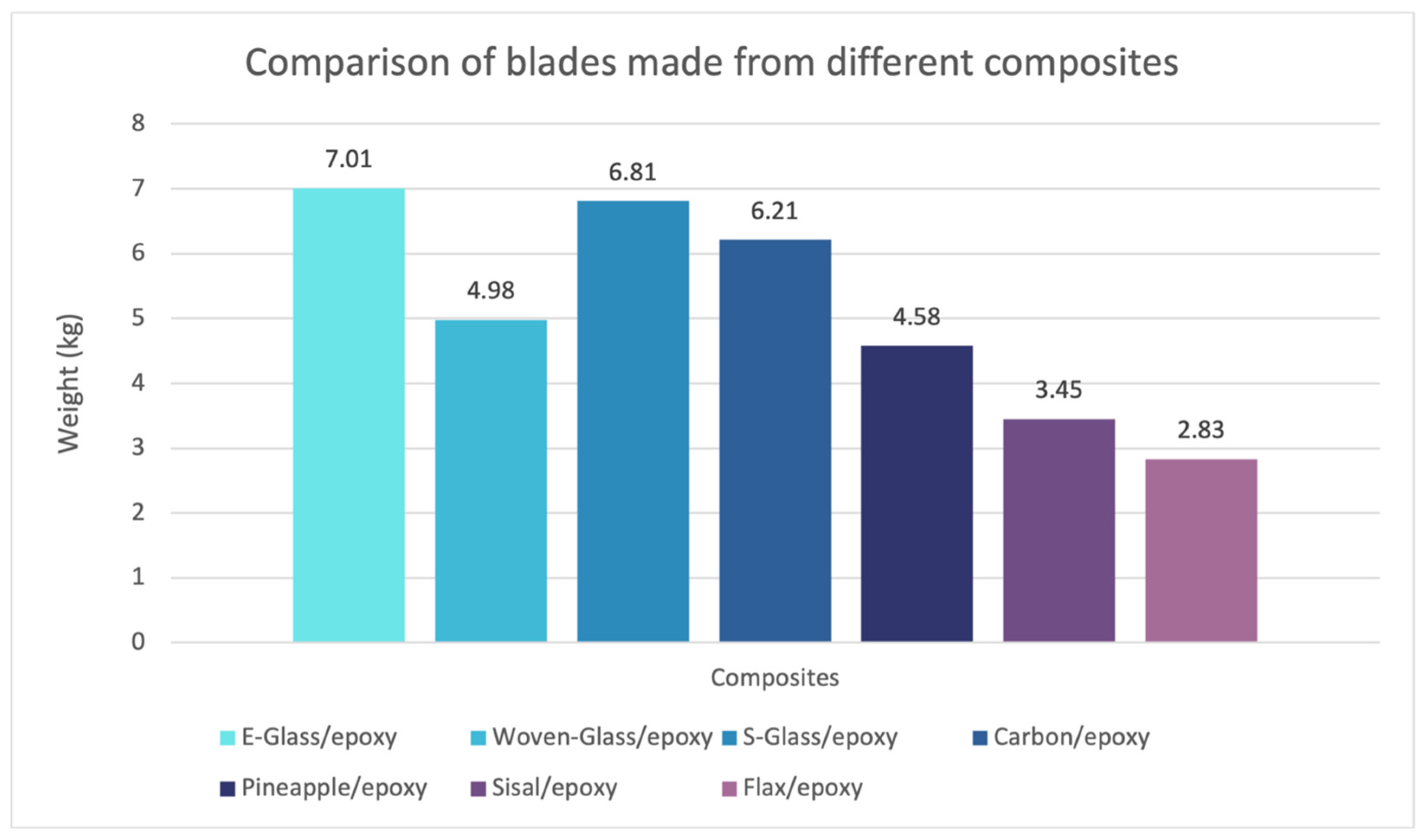
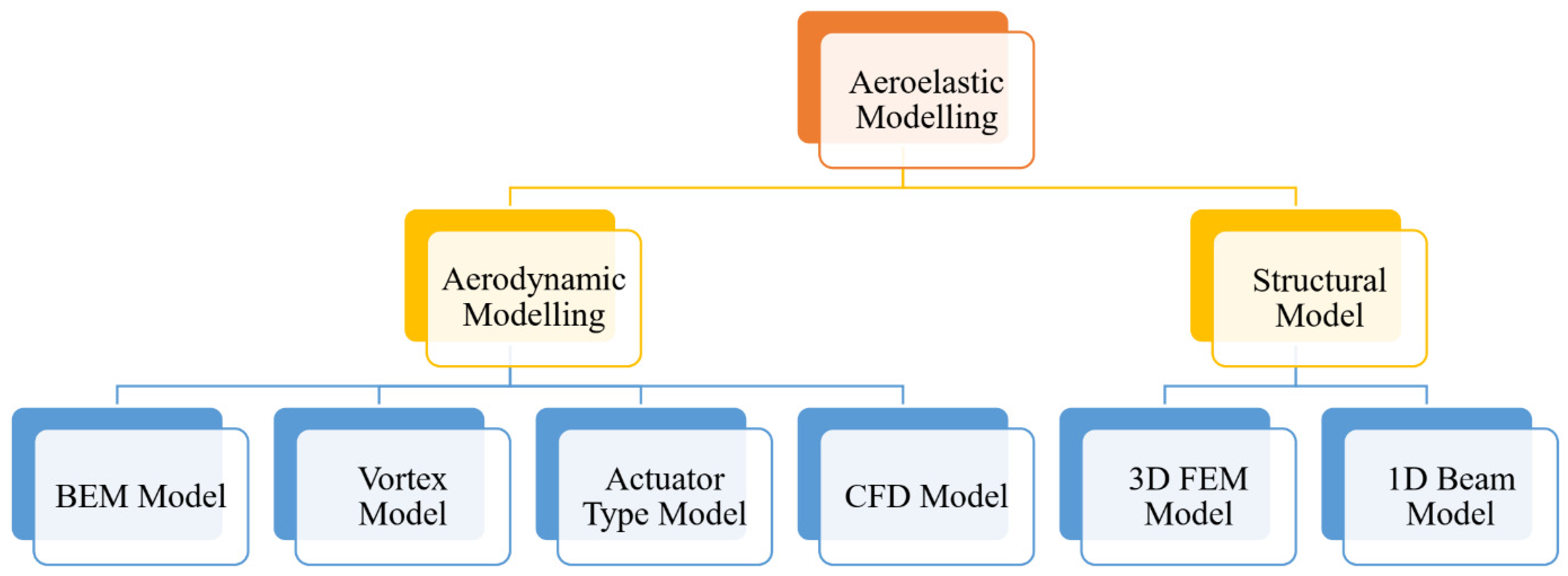
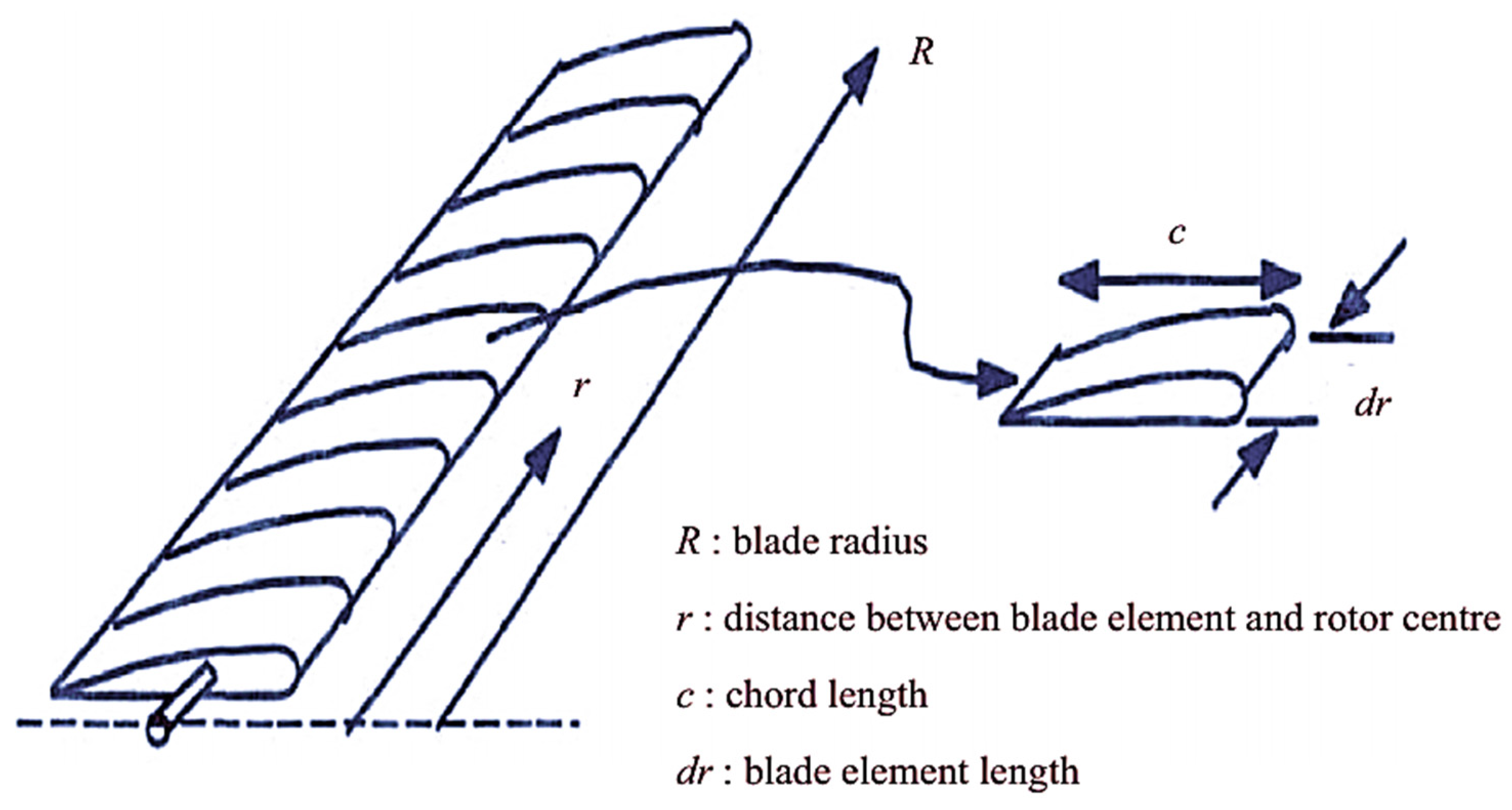



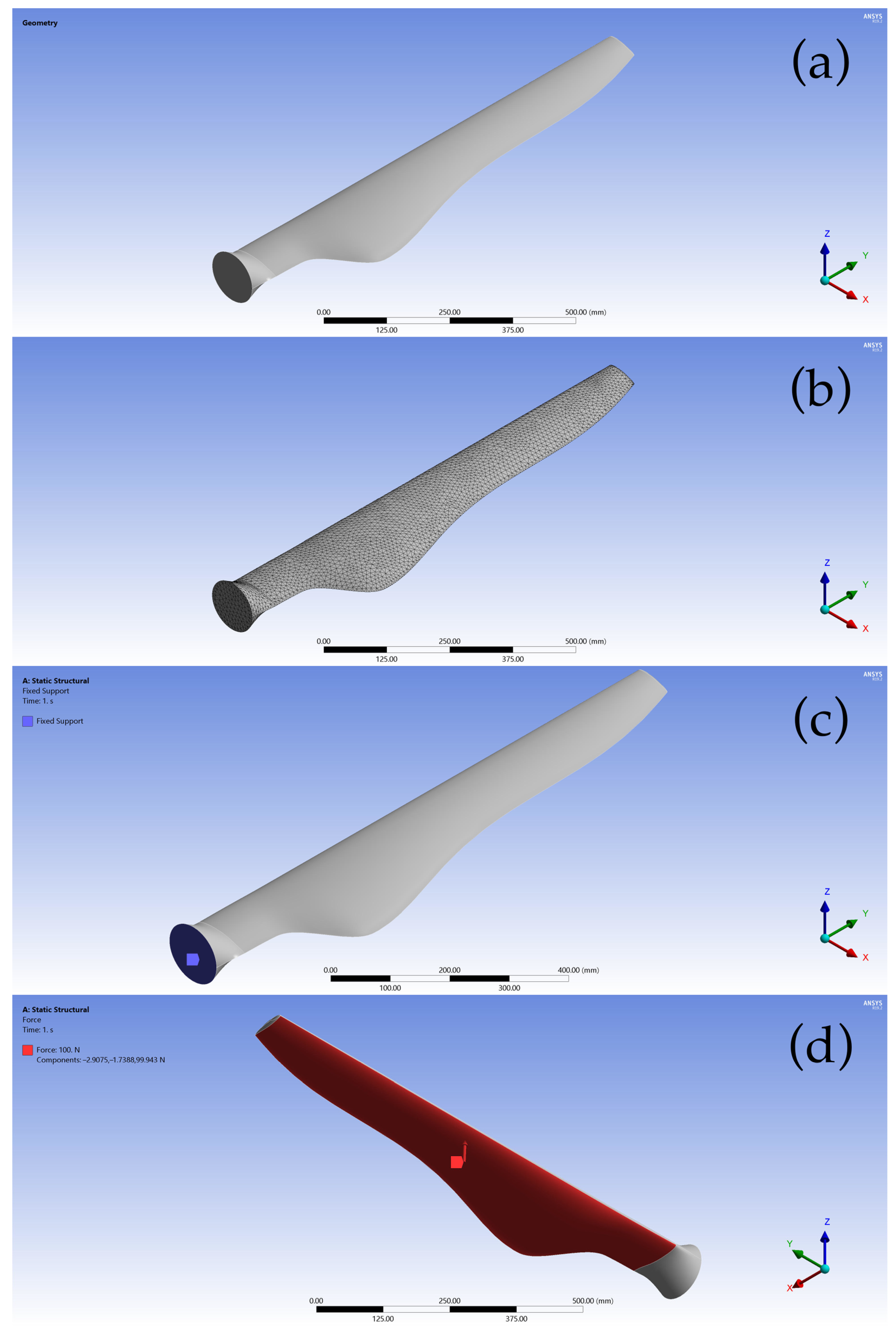



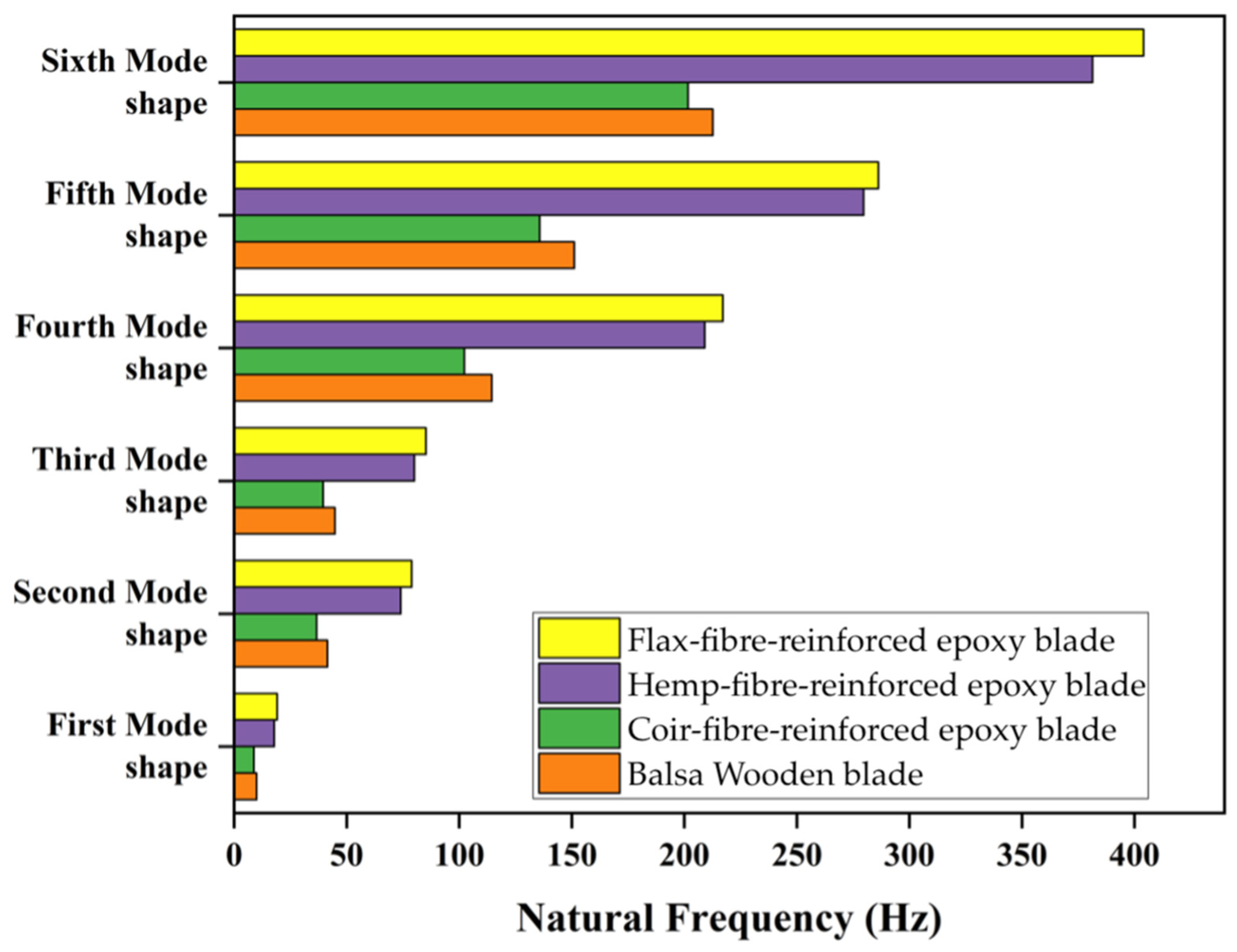



| S. no | Total Number of Elements | Total Deformation (mm) at the Blade Tip for 100 N Wind Load |
|---|---|---|
| 1 | 9053 | 11.65 |
| 2 | 13,653 | 10.38 |
| 3 | 26,789 | 8.14 |
| 4 | 38,542 | 4.62438 |
| 5 | 60,274 | 4.62127 |
| Properties of Different Materials | Balsa Wood | Hemp Fibre Composite | Coir Fibre Composite | Flax Fibre Composite |
|---|---|---|---|---|
| Density, kg/m3 | 160 | 1346.8 | 1150 | 1365 |
| Y’s * Modulus (Ex) GPa | 0.89 | 23.968 | 5 | 27.393 |
| Y’s Modulus (Ey) GPa | 0.89 | 23.968 | 5 | 27.393 |
| Y’s Modulus (Ez) GPa | 0.89 | 3.3 | 3.3 | 3.3 |
| Poisson’s ratio, νxy | 0.38 | 0.221 | 0.3 | 0.396 |
| Poisson’s ratio, νyz | 0.38 | 0.221 | 0.3 | 0.396 |
| Poisson’s ratio, νzx | 0.38 | 0.32 | 0.32 | 0.32 |
Disclaimer/Publisher’s Note: The statements, opinions and data contained in all publications are solely those of the individual author(s) and contributor(s) and not of MDPI and/or the editor(s). MDPI and/or the editor(s) disclaim responsibility for any injury to people or property resulting from any ideas, methods, instructions or products referred to in the content. |
© 2023 by the authors. Licensee MDPI, Basel, Switzerland. This article is an open access article distributed under the terms and conditions of the Creative Commons Attribution (CC BY) license (https://creativecommons.org/licenses/by/4.0/).
Share and Cite
Raj, E.F.I.; Appadurai, M.; Ram, V.; Gnaniah, A.M.; Salkuti, S.R. Natural-Fibre-Reinforced Composite-Based Micro-Size Wind Turbines: Numerical Analysis and Feasibility Study. J. Compos. Sci. 2023, 7, 197. https://doi.org/10.3390/jcs7050197
Raj EFI, Appadurai M, Ram V, Gnaniah AM, Salkuti SR. Natural-Fibre-Reinforced Composite-Based Micro-Size Wind Turbines: Numerical Analysis and Feasibility Study. Journal of Composites Science. 2023; 7(5):197. https://doi.org/10.3390/jcs7050197
Chicago/Turabian StyleRaj, E. Fantin Irudaya, M. Appadurai, Vishal Ram, Augustine Mathu Gnaniah, and Surender Reddy Salkuti. 2023. "Natural-Fibre-Reinforced Composite-Based Micro-Size Wind Turbines: Numerical Analysis and Feasibility Study" Journal of Composites Science 7, no. 5: 197. https://doi.org/10.3390/jcs7050197
APA StyleRaj, E. F. I., Appadurai, M., Ram, V., Gnaniah, A. M., & Salkuti, S. R. (2023). Natural-Fibre-Reinforced Composite-Based Micro-Size Wind Turbines: Numerical Analysis and Feasibility Study. Journal of Composites Science, 7(5), 197. https://doi.org/10.3390/jcs7050197







